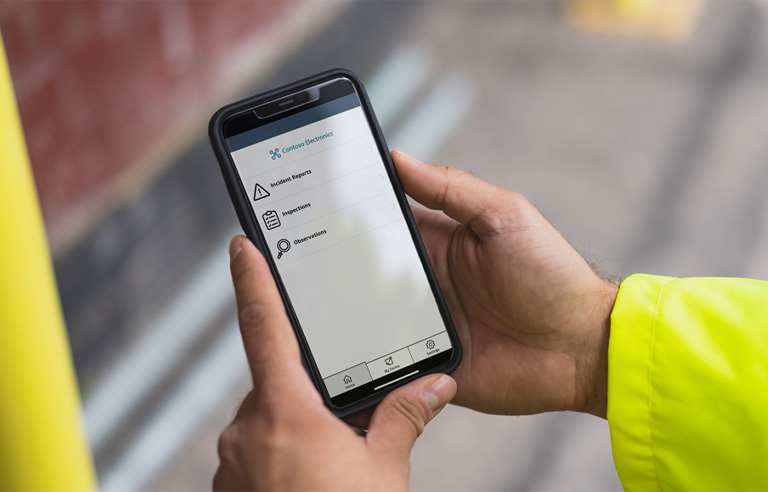Can I Use Microsoft Power Apps for Incident Reporting?


We know it happens: You notice a safety issue, but your internet connection is too poor to be able to report it or no desktop computer is in sight. However, for efficient environmental, health and safety management, you need to be able to report incidents and hazards whenever and wherever.
Additionally, the time to remove safety barriers is now. In 2023, half of frontline workers indicated they might quit within a year when they perceived their company didn’t prioritize safety.
Therefore, providing employees with an app for incident reporting on the go is a great opportunity to strengthen your safety management. Developing a safety app on your own is time-consuming though and comes with IT risks. With 13 cyberattacks happening every second in the United States, you need a bulletproof app to protect your data.
This is where safe Microsoft technologies can assist. Did you know there’s a way to use Microsoft Power Apps for incident reporting, without having to build a thing? Let’s discover how this solves common EHS problems.
Barriers to incident reporting
Understanding what keeps frontline workers from reporting an incident is key to an effective safety culture.
Most often, it comes down to simple communication barriers that prevent safety engagement. A missing phone signal or the required use of intrinsically safe devices that don’t cause any sparks in high-risk settings (and subsequently restrict internet access) can turn incident reporting into a bigger task than it should be.
Echoing this, Verdantix identified real-time access to safety procedures and data as a growing demand among frontline workers.
The less workers perceive incident reporting as a disruption to their routine, the more likely they’ll adopt new procedures. If you can allow incident reporting straight from a mobile app that also works offline, you remove a major barrier to safety communication.
However, introducing a new, separate application to frontline workers comes with the risk of being perceived as “just another thing on top.”
The good news, though, is there’s a solution – and it’s right on Microsoft.
Making incident reporting quick and easy
If you’re a large enterprise, then you have a huge opportunity for EHS in front of you – Microsoft Power Apps.
Microsoft Power Apps provides the ability to roll out corporate apps on a centralized platform, making it perfect for organizations already using Microsoft 365 day to day.
Frontline workers can easily adapt because they login using their existing Microsoft credentials and experience a familiar user interface – you may well already have Power Apps for other parts of the business.
However, although Microsoft gives you the option to build a Power App yourself, you might want to hold off if you want scale and robustness – especially if you’re a large business. Instead, enterprises can use a Power App developed by Microsoft partner Pro-Sapien that enables offline incident reporting. It’s backed up by Pro-Sapien’s complete, supported, globally used EHS management solution in Microsoft 365.
Next to user friendliness – which, crucially, makes it easier for employees to report incidents – there’s also another major benefit of using Power Apps ...
Protecting your incident data
With cybercrimes expected to cost enterprises $10.5 trillion by 2025, it’s clear that you need an EHS app that’s as secure as possible, especially because health and safety data is particularly sensitive and at risk.
Therefore, the age of “citizen developers” is over, as enterprises recognize the need for robust, secure applications that stand up to scrutiny – not something EHS professionals have time to create or, indeed, support.
So, with Microsoft Power Apps, such as the one by Pro-Sapien, you have a solution that’s not only familiar to end users, but to IT, too.
Like Microsoft 365, Power Apps is hosted in Microsoft Azure.
Azure has more than 3,500 Microsoft engineers working behind the scenes to keep you safe from cyberattacks and protect your data, making Power Apps and Azure a secure choice.
Increasing incident reporting with Power Apps
In conclusion, to solve incident reporting on the go with an app, you have to keep two things in mind: usability and IT security.
By using Power Apps with the likes of Pro-Sapien, you have the best of both worlds. With single sign-on, field workers can quickly report a safety incident or observation – even without a phone signal. Further, the Power Platform is built to provide industry-leading protection, with national security agencies, financial institutions and health care providers trusting Microsoft with their most sensitive information.
The best part is: Pro-Sapien has already done the build for you.
So, are you ready to make incident reporting much easier and engage workers? Discover more about the Pro-Sapien Power App today.
Post a comment to this article
Safety+Health welcomes comments that promote respectful dialogue. Please stay on topic. Comments that contain personal attacks, profanity or abusive language – or those aggressively promoting products or services – will be removed. We reserve the right to determine which comments violate our comment policy. (Anonymous comments are welcome; merely skip the “name” field in the comment box. An email address is required but will not be included with your comment.)

